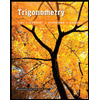Find the present value for a $85,000 investment for 11 years at a compounded continuously at 3.2%.
Find the present value for a $85,000 investment for 11 years at a compounded continuously at 3.2%.
Trigonometry (11th Edition)
11th Edition
ISBN:9780134217437
Author:Margaret L. Lial, John Hornsby, David I. Schneider, Callie Daniels
Publisher:Margaret L. Lial, John Hornsby, David I. Schneider, Callie Daniels
Chapter1: Trigonometric Functions
Section: Chapter Questions
Problem 1RE:
1. Give the measures of the complement and the supplement of an angle measuring 35°.
Related questions
Question
100%
![**Problem Statement**
Calculate the present value of an $85,000 investment over 11 years, with continuous compounding at an interest rate of 3.2%.
**Solution Approach**
To find the present value of an investment under continuous compounding, you can use the formula:
\[ PV = FV \times e^{-rt} \]
Where:
- \( PV \) is the present value.
- \( FV \) is the future value or the amount of the investment ($85,000).
- \( r \) is the annual interest rate (3.2%, or 0.032 in decimal form).
- \( t \) is the time in years (11 years).
- \( e \) is the base of the natural logarithm, approximately 2.71828.
**Detailed Explanation**
The provided image shows a mathematical problem that involves calculating the present value using the concept of continuous compounding. Continuous compounding offers the most frequent method of compounding, which calculates interest assuming that the compounding period is infinitely small. This results in a slightly higher amount of interest accrued compared to other compounding methods (e.g., annually, semi-annually).
**Interactive Component**
An interactive box is included for users to input their calculated present value based on their own work, facilitating engagement with the mathematical concepts discussed.](/v2/_next/image?url=https%3A%2F%2Fcontent.bartleby.com%2Fqna-images%2Fquestion%2F306f2d1a-9f72-422e-b433-8de8d735b303%2F8f1e3eac-ad6a-42bb-b98e-52e86dd84eeb%2Fjgwkz0r_processed.jpeg&w=3840&q=75)
Transcribed Image Text:**Problem Statement**
Calculate the present value of an $85,000 investment over 11 years, with continuous compounding at an interest rate of 3.2%.
**Solution Approach**
To find the present value of an investment under continuous compounding, you can use the formula:
\[ PV = FV \times e^{-rt} \]
Where:
- \( PV \) is the present value.
- \( FV \) is the future value or the amount of the investment ($85,000).
- \( r \) is the annual interest rate (3.2%, or 0.032 in decimal form).
- \( t \) is the time in years (11 years).
- \( e \) is the base of the natural logarithm, approximately 2.71828.
**Detailed Explanation**
The provided image shows a mathematical problem that involves calculating the present value using the concept of continuous compounding. Continuous compounding offers the most frequent method of compounding, which calculates interest assuming that the compounding period is infinitely small. This results in a slightly higher amount of interest accrued compared to other compounding methods (e.g., annually, semi-annually).
**Interactive Component**
An interactive box is included for users to input their calculated present value based on their own work, facilitating engagement with the mathematical concepts discussed.
Expert Solution
This question has been solved!
Explore an expertly crafted, step-by-step solution for a thorough understanding of key concepts.
This is a popular solution!
Trending now
This is a popular solution!
Step by step
Solved in 2 steps with 2 images

Recommended textbooks for you

Trigonometry (11th Edition)
Trigonometry
ISBN:
9780134217437
Author:
Margaret L. Lial, John Hornsby, David I. Schneider, Callie Daniels
Publisher:
PEARSON

Trigonometry (MindTap Course List)
Trigonometry
ISBN:
9781305652224
Author:
Charles P. McKeague, Mark D. Turner
Publisher:
Cengage Learning


Trigonometry (11th Edition)
Trigonometry
ISBN:
9780134217437
Author:
Margaret L. Lial, John Hornsby, David I. Schneider, Callie Daniels
Publisher:
PEARSON

Trigonometry (MindTap Course List)
Trigonometry
ISBN:
9781305652224
Author:
Charles P. McKeague, Mark D. Turner
Publisher:
Cengage Learning


Trigonometry (MindTap Course List)
Trigonometry
ISBN:
9781337278461
Author:
Ron Larson
Publisher:
Cengage Learning